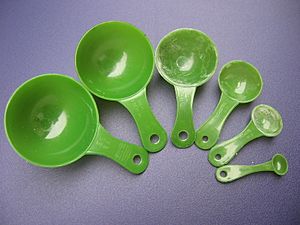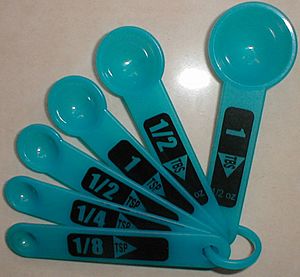Measuring spoon facts for kids
A measuring spoon is a special spoon that helps you measure the right amount of ingredients when you are cooking or baking. You can use them for both liquids, like water or oil, and dry things, like flour or sugar. Measuring spoons come in many different sizes. They are often made from plastic or metal.
Contents
Measuring Spoons Around the World
Measuring spoons can be a little different depending on where you are in the world. This is because different countries use slightly different standard sizes for their spoons.
Metric Measuring Spoons
Many countries use the metric system for measuring. Metric measuring spoons often come in sets of four to six spoons. These sets usually include common sizes like:
- 100 milliliters (ml)
- 15 milliliters (ml) for a tablespoon
- 5 milliliters (ml) for a teaspoon
Sometimes, these spoons have lines inside them to show half or quarter measures. You might also find separate spoons for these smaller amounts.
Measuring Spoons in the U.S.
In the United States, measuring spoon sets usually have four to six spoons. A typical set includes:
- One-quarter (¼) of a teaspoon
- One-half (½) of a teaspoon
- One (1) teaspoon
- One (1) tablespoon
A traditional U.S. teaspoon holds about 4.9 milliliters. A U.S. tablespoon holds about 14.8 milliliters. These sizes are very close to the standard metric spoons.
Measuring Spoons in Japan
In Japan, people often use two main measuring spoons:
- A large spoon (called Ōsaji) holds 15 milliliters.
- A small spoon (called Kosaji or Shōsaji) holds 5 milliliters.
Sometimes, a much smaller spoon is used. This spoon is usually 2.5 milliliters, which is half of a small spoon.
Measuring Spoons in Australia
Australia has a slightly different size for its tablespoon compared to most other places.
- One Australian tablespoon is equal to 20 milliliters.
- This is the same as two dessertspoons, where each dessertspoon is 10 milliliters.
- It is also the same as four teaspoons, where each teaspoon is 5 milliliters.
Why Not Use Regular Spoons for Measuring?
You might have spoons in your kitchen that look like teaspoons or tablespoons. These are called cutlery spoons. They are used for eating, not for exact measuring.
Cutlery spoons are not made to standard sizes. A regular teaspoon might hold anywhere from 2.5 to 7.3 milliliters. A regular tablespoon might hold from 7 to 20 milliliters. This means they can be much smaller or much larger than a true measuring spoon.
Using cutlery spoons for important measurements can be risky. For example, if you need to measure medicine, using a regular spoon could mean you get too much or too little. This is why it's always best to use proper measuring spoons when accuracy is important.
See also
 In Spanish: Cuchara medidora para niños
In Spanish: Cuchara medidora para niños



